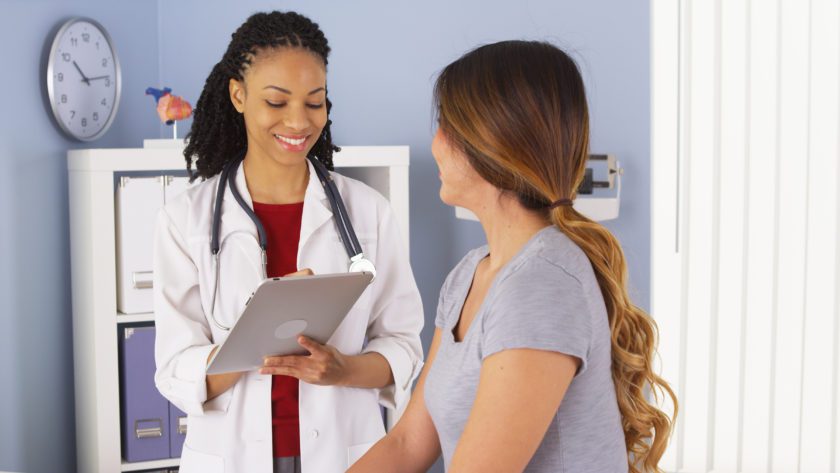 One of the most important ways for women at any age to stay healthy and live longer is to get recommended screening tests.
One of the most important ways for women at any age to stay healthy and live longer is to get recommended screening tests.
These tests can detect diseases, such as cancer, heart disease, osteoporosis, and more, early when they are easier to treat.
NOTE: If you have risk factors, a diagnosed condition, or a family history of certain diseases, talk to your physician. The types of tests, when you start testing, and how often you test may differ from the standard recommendations below.
The U.S. Preventive Services Task Force recommends screening for the following diseases:
1. Obesity
Have your Body Mass Index (BMI) calculated to screen for obesity. BMI is a tool that is used to measure body fat by the weight (in kilograms) to height (in meters) ratio of an individual.
A BMI of 25 – 29.9 kg/m indicates overweight and a BMI greater than 30 kg/m indicates obesity.
You can use the BMI calculator from the National Heart, Lung, and Blood Institute to find your own BMI.
2. Breast Cancer (age 40+)
Starting at age 20, the American Cancer Society recommends getting a Clinical Breast Exam (CBE) by your health care provider about every 3 years.
Breast self-exam (BSE) is also an option for women starting in their 20s. At age 40, you should have a mammogram every year and a CBE prior to the mammogram.
3. High Cholesterol (age 45+)
Starting at age 45, have your blood checked regularly for cholesterol levels (fasting blood test). Talk to your provider about testing earlier if you are younger than 45 and if:
- You have diabetes.
- You have high blood pressure.
- You have a family history of heart disease.
- You smoke.
4. Cervical Cancer (age 21 or within three years of having sex for the first time)
Starting at age 21 or within three years of your first sexual encounter (whichever is first), you should have a Pap test. The American Cancer Society recommends getting a regular Pap test every year.
If your provider uses the newer liquid-based Pap test, testing can be done every 2 years. A pelvic exam should be performed with each Pap test.
Beginning at age 30, if you have had three consecutive normal Pap test results, you may be able to test every two to three years.
5. High Blood Pressure (age 18+)
Starting at age 18, have your blood pressure checked at least every two years. A blood pressure reading of 140/90 and above is high.
6. Colorectal Cancer (age 50+)
Starting at age 50, your physician can decide which test is right for you.
7. Diabetes (age 45+)
Starting at age 45, screen for Type 2 Diabetes. Test earlier if you have any of the following risk factors as they can increase your risk of getting this disease:
- Family history of diabetes
- Race or ethnic background — Hispanics, Blacks, Native Americans, and Asians tend to be more highly affected.
- Metabolic syndrome (also called insulin resistance syndrome)
- Overweight — Defined as a Body Mass Index (BMI) greater than 25.
- Habitually inactive
- Hypertension (high blood pressure)
- Abnormal cholesterol levels — HDL (“good”) cholesterol level is under 35 mg/dL (milligrams per deciliter) and/or triglyceride level is over 250 mg/dL.
- History of gestational diabetes — Getting diabetes during pregnancy OR delivering a baby over nine pounds.
- History of polycystic ovary disease (PCOS)
- History of vascular disease (such as stroke)
8. Osteoporosis or thinning of the bones (age 65+)
Starting at age 65, have a bone density test. If you weigh less than 154 lbs. and are between the ages of 60 and 64, consult your provider about being tested. If you are at risk for osteoporosis, screen at an earlier age.
9. Chlamydia and other STD’s (sexually transmitted diseases)
Have STD tests if you are sexually active and you and your partner are not monogamous.
10. Eye diseases (age 20+)
For individuals who have symptoms at any age or who have a family history of eye disease, diabetes or high blood pressure, the American Academy of Ophthalmology recommends that you see your ophthalmologist to determine how frequently your eyes should be examined.
Symptoms may include:
- Visual changes or pain
- Flashes of light
- Seeing spots or ghost-like images
- Lines appear distorted or wavy
- Dry eyes with itching and burning
According to the Academy, you should have a complete eye exam at least once between the ages of 20 and 29 and at least twice between the ages of 30 and 39.
At age 40, early signs of disease and changes in vision begin to occur, and you should get a baseline examination to screen for:
- Cataracts
- Glaucoma
- Ocular tumors
- Systemic diseases that affect the eye (i.e. hypertension and diabetes)
- Diabetic retinopathy
- Other eye conditions
Between ages 40 and 64, have an exam every two to four years. After age 65, you should have complete eye exams every one to two years.
11. Skin cancer
According to the American Cancer Society, your skin should be examined by your provider as part of a routine health checkup to look for cancerous and pre-cancerous conditions. In-between exams, it is recommended that you check your own skin once a month. See Why I’m Now a Statistic — Protect Yourself Against Skin Cancer
The American Academy of Dermatology, Skin Cancer Foundation, and the 1992 National Institutes of Health Consensus Conference on Early Melanoma recommend annual screening for all patients.
6.12.2009





